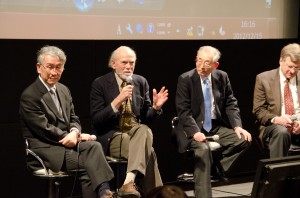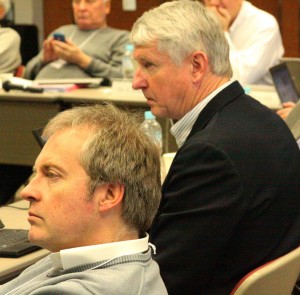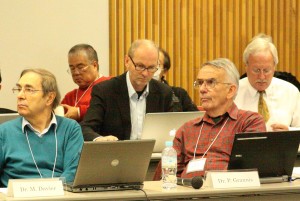The final deliverable for the Global Design Effort (GDE) is the Technical Design Report (TDR) for the ILC. We completed a draft TDR last November and submitted it for review. The accelerator volumes of the TDR consist of one volume on the R&D programme accomplishments and future programme and a second volume on the ILC design we have developed. The TDR design began from the Reference Design Report (RDR) and made changes optimising it for cost, performance and risk. The TDR and Detector Baseline Design (DBD) underwent a technical review on 13 and 14 December at KEK by the ILCSC Programme Advisory Committee (PAC) augmented by some additional technical experts. The main conclusion of the review was to endorse the technical design we have presented in the TDR. They recommend “no changes in the TDR.” They do identify items to be addressed in the future.
We are very pleased with the outcome of the TDR technical review, as it represents a major step towards finalising the TDR that is scheduled to be submitted to ICFA in June. The PAC comments and recommendations will be helpful in setting out the ongoing programme for the next phase of the ILC, hopefully leading to a construction project.
The PAC report summarises our TDR presentations and makes the following set of recommendations:
- The PAC was very impressed by the GDE presentations to the Committee, and supports the TDR. What follows are recommendations by the Committee on items that need to be addressed in the future; however, the PAC recommends no changes to the TDR.
- The lack of progress towards the 37 nm ATF2 IP goal is a concern. Several issues have already been resolved, and the currently scheduled modifications should lead to significant progress towards the goal.
- Sufficient progress has been made on SCRF that the TDR sections on cavity gradient can be defended. The desired gradient is well within reach, and several manufactures have been validated. XFEL industrialization will give valuable information.
- The Japanese power coupler appears to be a good design, and should be pursued further to be adaptable to the TESLA-type cavity (having the smaller cold-end interface flange).
- It would be valuable to obtain more operational statistics on the Marx modulator.
- The Klystron Cluster Scheme (KCS) appears to solve several important problems, but several issues remain currently open:
- More test time of the system is needed
- It is not clear how well the current LLRF system will operate with KCS
- Can the system be aligned well enough that no other modes are excited?
- The effects of a fault in the power line should be studied further to ensure that no damage will be caused by the high power levels involved.
- A coupler breakdown in KCS could lead to availability issues.
- It is not clear how precise adjustment of the coaxial tap-offs (CTOs) can be achieved and maintained at high power operation to ensure the right coupling ratio and matching.
- More evaluation is needed of cavity tuner designs.
- Alternate cavity designs producing higher gradients could be valuable for future upgrades, but the current design is appropriate for a linear collider proposal.
- Are there any advantages to having a 1.9 K liquid helium system?
- More R&D appears to be needed on the positron source:
- A technical design of the rotating target should be established; it has to be compatible with ultra-high vacuum; enable fast rotation; and be robust to radiation damage.
- The flux concentrator as a matching device should be demonstrated
- A realistic scenario of installation and path-length adjustment for positron operation should be established.
- The overall ILC cost was reduced a few years ago by shortening the damping ring from 6 km to 3 km. To keep the luminosity constant the beam sizes etc. at the IP were reduced. Thus, tolerances in several parts of the system became tighter. The recommendation is to complete a new overall tolerance study.
- The IDAG presentation to the PAC meeting summarizes the recommendations on the ILC detectors, with an additional PAC comment below.
- The two ILC detector designs have different L*s (distance to the IP from 1st quad). These were requested by the detector groups. If these two L*s were made the same, the retuning time between push-pull detector set-ups could be made shorter.
The recommendations for the most part presents a set of recommendations that will help guide future work, but item 2 represents an important unfinished GDE task. The only major R&D goal we set out early for the GDE that has not been achieved is to demonstrate a 37-nm vertical beam size on the ATF-2, which is essentially equivalent to the ILC goal. The earthquake in Japan set this work back by about one year. Notably, ATF-2 achieved promising results soon after the PAC review. Nevertheless, our plan is to perform a GDE review of ATF-2 in April to assess achievements to date and a future plan that will demonstrate ILC goals. I will report on that review and plans for ATF-2 later this spring.
The ILC Detector Baseline Design (DBD) was also reviewed at this review. In parallel with development of the TDR over recent years, the detector designs have also been developed since the RDR. This DBD has been developed under the guidance of IDAG, a special review committee chaired by Michel Davier and reporting to the Research Director, Sakue Yamada. Since the PAC consists mostly of accelerator experts, the DBD review relied on the IDAG report. The general assessment of IDAG of the DBD made the following points:
- The ILC physics case has been strongly documented
- The 125 GeV boson gives a solid boost for an accelerator beyond the LHC
- The two validated detector concepts have demonstrated that the physics goals can be met
- The physics processes studied cover the full range of ILC operation from 250 GeV to 1 TeV
- A vigorous R&D program has validated the detector subsystem solutions
- Detector R&D should continue
- The detector designs have met the challenge of ILC physics
- Many results rely on particle flow, which drives much of the detector designs
Davier noted that DBD editing is still needed; benchmarking still needs to be crosschecked; and more work is still needed on ILD costing. He wondered whether there were any remaining risks to achieving the desired performance, such as power pulsing (which has yet to be tested on prototypes), and also the large solenoids, which have features beyond those of any existing detector solenoids.

Panel Discussion at the TDR Draft handover ceremony in Tokyo. From the left: Atsuto Suzuki, Barry Barish, Sakue Yamada and Jon Bagger.
An intense few days of technical review were followed by a special event in Tokyo commemorating our completion and submission of the draft TDR. The morning session had presentations on “Progress of Particle Physics and International Linear Collider” by Sachio Komamiya (University of Tokyo) and a talk on “From LHC to Linear Collider” by Lyn Evans (Imperial College, London) for a general audience. Then, in the afternoon, was a special session for invited members of the press, which consisted of talks by Sakue Yamada and myself, a draft TDR presentation ceremony, and a special panel discussion moderated by Hitoshi Murayama. Finally, there was a lively question and answer period with the press. The interest in the Linear Collider continues to increase and the possibility of it being sited in Japan has captured much attention beyond the high energy physics community.
The next stop on our busy winter TDR review schedule will be an International Cost Review, chaired by Norbert Holtkamp, and carried out in London in February. We have worked very hard to prepare for this next review and I will report on the outcome in a coming Director’s Corner.




Recent Comments